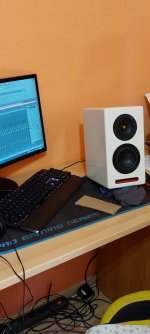Or not. Increased higher frequencies (eg breakup) give the illusion of detail, but it's not correct detail. Therefore you could have that sound also using other cone materials if you EQ the speaker so.There is nothing wrong with a hard cone but it is very truthful,
This is an example of why it's difficult to talk in subjective terms, without also being very specific.
The speaker can only do so much on its own. There are so many bases to cover with good execution, and there may also be some variation as to the 'optimum' for a given cone material.
In rough order of thoughts...
Say you've picked some strong candidates with the different cone materials. Some of the parameters will be different by necessity, like cone mass, which could affect things downstream like box size.
Baffle design. Paper that 'beams' more may be more forgiving with a flat baffle and classic sharp corners. For ceramic with its wide dispersion and corresponding bright room response, a wave guide and smooth chamfers could be in order. The relative driver sizes also have to play well together. The usual "house curve" seems to be omnidirectional bass, becoming progressively more directional with increasing frequency. So an "odd one out" ceramic mid may be quite difficult if you are unprepared.
~~
A big advantage of active filters is that they limit the frequency bands seen by the amplifier channels, so IMD is lower. For the ultimate in satisfaction, I juggle a mix of active filters, minimalist coils and capacitors, and home-brew amplifiers.
But I'm weird like that. Even with zero or minimal electronics, it should still be possible to venture down a path like a Nelson Pass active XO, routed to a good quality bass amplifier, and maybe a F1 or F2 for the mids and highs.
Then, there could be a newfound appreciation for complex musical passages, which would otherwise be simply too harsh and bright sounding.
In rough order of thoughts...
Say you've picked some strong candidates with the different cone materials. Some of the parameters will be different by necessity, like cone mass, which could affect things downstream like box size.
Baffle design. Paper that 'beams' more may be more forgiving with a flat baffle and classic sharp corners. For ceramic with its wide dispersion and corresponding bright room response, a wave guide and smooth chamfers could be in order. The relative driver sizes also have to play well together. The usual "house curve" seems to be omnidirectional bass, becoming progressively more directional with increasing frequency. So an "odd one out" ceramic mid may be quite difficult if you are unprepared.
~~
A big advantage of active filters is that they limit the frequency bands seen by the amplifier channels, so IMD is lower. For the ultimate in satisfaction, I juggle a mix of active filters, minimalist coils and capacitors, and home-brew amplifiers.
But I'm weird like that. Even with zero or minimal electronics, it should still be possible to venture down a path like a Nelson Pass active XO, routed to a good quality bass amplifier, and maybe a F1 or F2 for the mids and highs.
Then, there could be a newfound appreciation for complex musical passages, which would otherwise be simply too harsh and bright sounding.
Last edited:
imho, no hopes if the active filter means adc then dac . So is must be a multichanel dac or op based pcb.
And it gives you not so many choice with multichannel dacs or it becomes rapidly very expensive for something that sounds good enough.
Minidsp Flex8 , Oktoresearch, one or two Studio products around the same price. Not so many choices for the average diyers if the target is to do better than a passive filter at the end (understand when the transfer function responses curves of the design are found; i.e. filter dev finished)
Quality of source matters. Although a bad filter design is worse than a bad source.
And it gives you not so many choice with multichannel dacs or it becomes rapidly very expensive for something that sounds good enough.
Minidsp Flex8 , Oktoresearch, one or two Studio products around the same price. Not so many choices for the average diyers if the target is to do better than a passive filter at the end (understand when the transfer function responses curves of the design are found; i.e. filter dev finished)
Quality of source matters. Although a bad filter design is worse than a bad source.
I have tested many midrange drivers and prefer these for the following reasons:
The Visaton B200 is the sweet spot in my opinion in that it has some body and weight that a smaller midrange driver cannot reproduce when crossed over at 100hz or lower. In the low mid range a 12" driver will sound better, though above say 200hz, an 8" driver or smaller will beat out a 10" or 12" every time. This driver is a bit fragile in my opinion and I have observed variance from one driver to the next. The commercial version, purchased through Mouser, seems to have more variance in tolerances indicated by buzzing noises, compared with a non-commercial? version purchased through Partsxpress. Both the same price in different packaging.
The Celestion CF0617M Neo version is the absolute cleanest midrange that I have tested without question. Better than any compression driver within a certain range. I prefer designing for a lower crossover point than the 300hz absolute limit of this driver. It is the powerful magnet, low mass cone and low excursion of this driver that enable it to perform so exceptionally. I will revisit this driver if I can find the right bass driver, enclosure, horn design to play up to 300hz to complement this outstanding driver.
Fostex FE126NV2 a hybrid in performance of the aforementioned two drivers and a bit more reliable and straight forward than the Visaton with better upper mids and highs.
Fostex FF165WK an outstanding midrange driver that is a bit more robust and capable of handling lower crossover points compared with the NV series. Not as lively as the NV2 series which is ultimately my preference for this reason.
Other drivers of note or interest:
Mark Audio MAOP 11s -- Outstanding clarity throughout their operating range. Perhaps the nicest mids I have heard in a near field implementation. Not as lively and dynamic as the aforementioned drivers though very clear and smooth. Look elsewhere if designing for listening distances at 10ft or greater as these cannot handle very loud inputs.
Seas FA22RCZ -- These are outstanding and competitive with the B200s. I prefer that they can handle a lower crossover point to a far greater degree compared with the Visatons. They do not have present the pop and upper mid energy of the Visatons which is more important to me especially given that a subwoofer with a low mass cone can operate up to 100hz adequately.
The two drivers of interest that remain to be tested are the Seas Exotic 8"s and AER drivers. I have tested some high end drivers from SupraVox and other brands and prefer the aforementioned drivers to those, primarily due to cost and simplicity, which I associate with peace of mind. I have been holding off on purchasing the Seas and AER drivers as I anticipate that they will be the best of the lot and have enjoyed the journey of exploring so many different drivers. In addition I prefer the utilitarian and relatively affordable nature of drivers like those from Fostex over premium unobtainium.
Other drivers of interest are small inexpensive Visaton paper cone woofers in a square or rectangular array, and any other contemporary drivers featuring similarly low mass cones.
The B&C DCM50 is yet another favorite though like the aforementioned Celestion I wish I could achieve a 100hz crossover with it. This B&C would be the only contender to the Celestion CF0617M which I prefer to the Celestion AXI. If I end up revisiting a design which is optimized for a 300hz crossover, these are the two drivers of choice of what's currently available, having tested several midrange compression drivers. A contemporary take on the Western Electric 555 with a paper or low mass phenolic textile diaphragm, and excursion enabling a 100hz crossover frequency or lower is the dream driver in my opinion. I am hopeful that further developments are made in the realm of midrange compression drivers.
The Visaton B200 is the sweet spot in my opinion in that it has some body and weight that a smaller midrange driver cannot reproduce when crossed over at 100hz or lower. In the low mid range a 12" driver will sound better, though above say 200hz, an 8" driver or smaller will beat out a 10" or 12" every time. This driver is a bit fragile in my opinion and I have observed variance from one driver to the next. The commercial version, purchased through Mouser, seems to have more variance in tolerances indicated by buzzing noises, compared with a non-commercial? version purchased through Partsxpress. Both the same price in different packaging.
The Celestion CF0617M Neo version is the absolute cleanest midrange that I have tested without question. Better than any compression driver within a certain range. I prefer designing for a lower crossover point than the 300hz absolute limit of this driver. It is the powerful magnet, low mass cone and low excursion of this driver that enable it to perform so exceptionally. I will revisit this driver if I can find the right bass driver, enclosure, horn design to play up to 300hz to complement this outstanding driver.
Fostex FE126NV2 a hybrid in performance of the aforementioned two drivers and a bit more reliable and straight forward than the Visaton with better upper mids and highs.
Fostex FF165WK an outstanding midrange driver that is a bit more robust and capable of handling lower crossover points compared with the NV series. Not as lively as the NV2 series which is ultimately my preference for this reason.
Other drivers of note or interest:
Mark Audio MAOP 11s -- Outstanding clarity throughout their operating range. Perhaps the nicest mids I have heard in a near field implementation. Not as lively and dynamic as the aforementioned drivers though very clear and smooth. Look elsewhere if designing for listening distances at 10ft or greater as these cannot handle very loud inputs.
Seas FA22RCZ -- These are outstanding and competitive with the B200s. I prefer that they can handle a lower crossover point to a far greater degree compared with the Visatons. They do not have present the pop and upper mid energy of the Visatons which is more important to me especially given that a subwoofer with a low mass cone can operate up to 100hz adequately.
The two drivers of interest that remain to be tested are the Seas Exotic 8"s and AER drivers. I have tested some high end drivers from SupraVox and other brands and prefer the aforementioned drivers to those, primarily due to cost and simplicity, which I associate with peace of mind. I have been holding off on purchasing the Seas and AER drivers as I anticipate that they will be the best of the lot and have enjoyed the journey of exploring so many different drivers. In addition I prefer the utilitarian and relatively affordable nature of drivers like those from Fostex over premium unobtainium.
Other drivers of interest are small inexpensive Visaton paper cone woofers in a square or rectangular array, and any other contemporary drivers featuring similarly low mass cones.
The B&C DCM50 is yet another favorite though like the aforementioned Celestion I wish I could achieve a 100hz crossover with it. This B&C would be the only contender to the Celestion CF0617M which I prefer to the Celestion AXI. If I end up revisiting a design which is optimized for a 300hz crossover, these are the two drivers of choice of what's currently available, having tested several midrange compression drivers. A contemporary take on the Western Electric 555 with a paper or low mass phenolic textile diaphragm, and excursion enabling a 100hz crossover frequency or lower is the dream driver in my opinion. I am hopeful that further developments are made in the realm of midrange compression drivers.
Last edited:
Maybe they are cheap but I really like the mids on my Dayton audio PS95s

dave
dave
Attachments
Last edited by a moderator:
See my new entry for Ugliest in the Fullrange Gallery, vintage 6x10 DEW-alnico plus woofer -- like eating creme brulee buttery rich crisply textured. Placing even higher would be vintage alnico 4x7 Rola used as wide-midrange in my 3-way Ultrae -- for ultra sultry -- resin-coated CF (sub-)midwoofer and big electrostatic (super-)tweeter. Most refined sweetness would go to Orgue alnico copy of classic Diatone P-610, not really fullrange. More high-tech and incredibly textured (as if tracing record grooves much deeper) would be fiberglass-honeycomb -- stronger than steel, lighter than paper. Finally, I really like SBA MW19TX-8 above 60hz; indeed Textreme MW seems more often used as midrange. Metal -- I'm breaking in 2"-cone Markaudio MAOP5 hoping (micro-)dynamics/articulation will improve with time. PP -- I've run 5" Mission straight-through, as Mission often had done back then.
Last edited:
I like this one very much. Measures well. TV speaker from JVC.
8cm fullrange driver with paper cone and DIY aluminium foil sandwich and Faraday copper ring.
https://www.diyaudio.com/community/...loudspeaker-sandwich-cone.402917/post-7443470

8cm fullrange driver with paper cone and DIY aluminium foil sandwich and Faraday copper ring.
https://www.diyaudio.com/community/...loudspeaker-sandwich-cone.402917/post-7443470
Forgot to mention Fostex FE108e∑ low-passed before the ~1.5khz steep rise. Extremely realistic sound favored by classical musicians.
Visaton B200 is the sweet spot in my opinion ...Seas FA22RCZ -- These are outstanding and competitive with the B200s
But only if some of their issues are fixed… B200 has a particularly nasty (laser beam) top and is reallyu hard to match with a tweeter. Phase plugs in the B200 do a lot towards fixing the top, i have yet to find a whizzer that doesn’t benefit from a phase plug. This is the phase plug i used, it needs a couple notches in the base to clear the non-flat part of the SEAS polepiece.
Can’t disagree with the comparison — once tweaked — the only 8” FR i could live with, The SEAS is easy to put in a box, the Visaton likes an OB (or a really big aperiodic box), on a big enuff baffle they can get away without a bass helper.
I passed my 4 x B200eN on because i couldn’t really come up with a box i liked. My FA22rcZeN sit in 45 litres sealed driven by an ACA (in the shop).

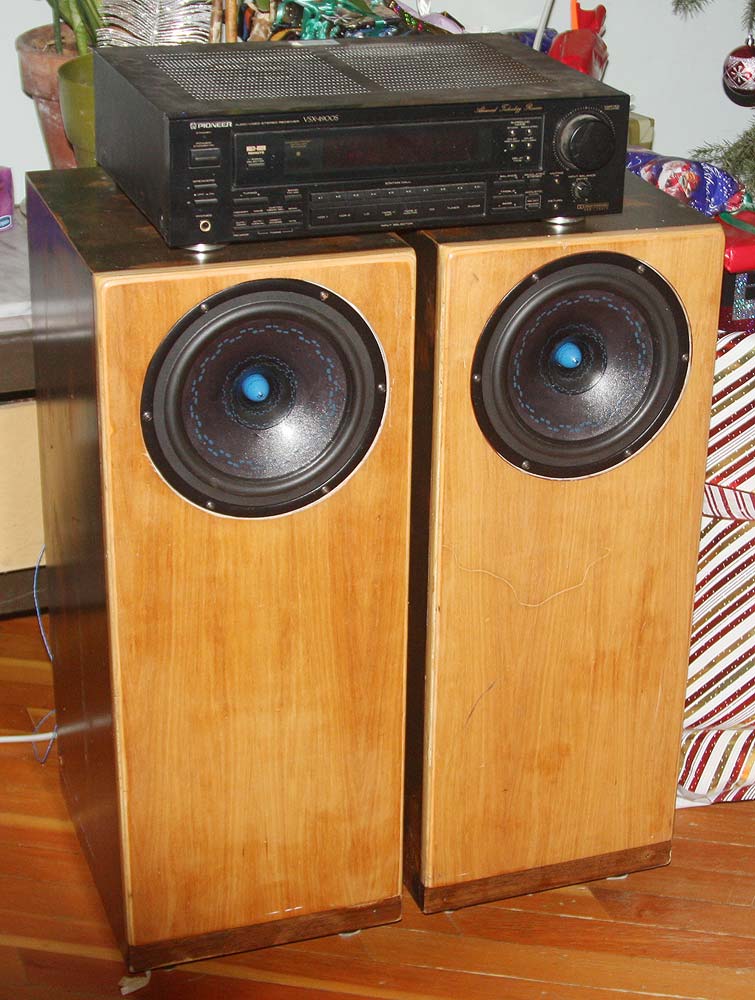
dave
Fostex FF165WK
Simple mods to ameriolate some of their issues and improve DDR a bit.
https://www.diyaudio.com/community/threads/opinions-on-mods-to-ff85wk.365756/post-6480912
dave
I have Fostex fe208 sigma new series.
Due to the structured cone very stiff and precise. Needs a bit eq in the highs.
Great loudspeaker
Due to the structured cone very stiff and precise. Needs a bit eq in the highs.
Great loudspeaker
Stop looking at the cone material, start looking at measurments. Frequency response and distortion will tell you a lot. Check out Zaph Audio and HiFi Compass to get started and make easy comparisons.
@milezone , so this the 16 ohms neo version ? https://celestion.com/product/cn0617m/ you EQ it with DSP ? What was the higher low pass cut-off you have good results with, please ?
It has a great X/max for a so high sensivity (certainly nearer to 96 dB than 99 dB) and the price too.
It has a great X/max for a so high sensivity (certainly nearer to 96 dB than 99 dB) and the price too.
Best midrange driver I've heard is from one of the PMC transmisiion lines, believe it had the ATC dome mid with a volt bass unit. Best midrange I've ever heard, hard to decide between horns and electrostatics.
Rob.
Rob.
One of my best hifi experience was those when I heard a pair of SCM150s. A relative simple (although still advanced looking compared to other dome mids) dome midrange from the last century which no one can recreate!? What could be the secret? A separate enclosure not even needed, because it brings his own.Simple answer and easy to remember……A…..T……C
Hi there, it is a quite ordinary room with my home office in there, the other big listening room is not ready yetHi,
Is it related to the average spl or did you feel it was also better at low average spl in a living room. I wonder if having such system push their owner to pump up the volume for a lot of reason. Like: those are big systems most of the time, so often means the owner has a house, so can push more easily the volumeand feel more bass and so on ?
Or is it something else, high efficienty, use of different things like tubes for amp, etc ?
I tried this one some time ago:
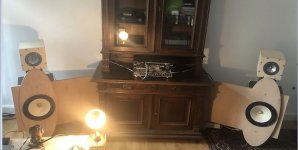
and changed to this very experimental setup, especially from a craftmanship point of view
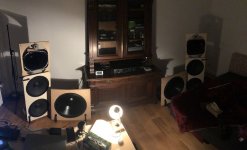
I went back to the small setup with the 4.5 inch KEF R3 coax with a Sonido woofer from a very large setup that was far too big for my home office
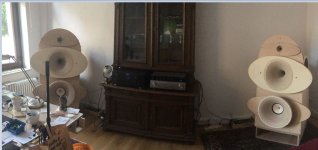
see also here for further details
https://www.diyaudio.com/community/threads/ultimate-open-baffle-gallery.123512/post-7393996
The first setup shown above was too large - i tried real downsizing but it was too boring although the measured over all SPL, CSD and WCD of the KEF coax + woofer in CB with massive active PEQ was looking good
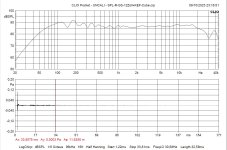
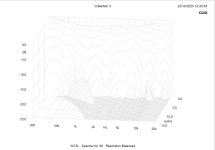
- i needed to go back to a open baffle to save some space with a decent midrange horn, not really down to 400 Hz but with the 18sound XT1464 and the B&C DCM414 quite close
Hope it helps to understand what i mean - Stefano
Last edited:
- Home
- Loudspeakers
- Multi-Way
- Most euphoric high-end midrange you have heard?
